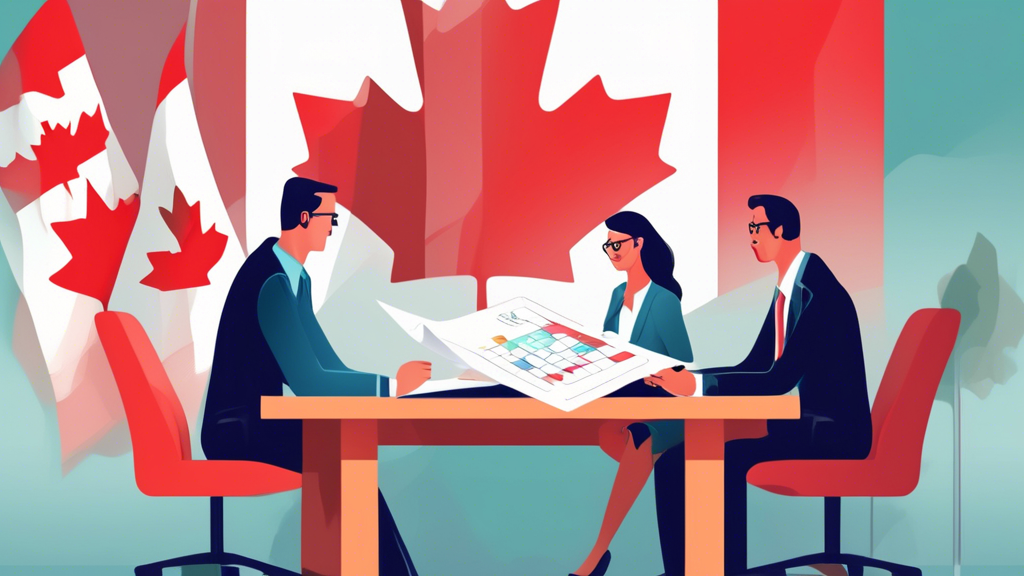Does Bankruptcy Clear CRA Debt? Understanding Your Options

Tyler McAllister
Senior Finance Writer
If you find yourself overwhelmed with Canada Revenue Agency (CRA) debt, you’re not alone. Many Canadians grapple with the daunting question: does bankruptcy clear CRA debt? This concern stems from a blend of financial strain and the fear of lingering obligations. Bankruptcy, a legal process designed to offer relief from insurmountable debt, often comes shrouded in myths and misconceptions, particularly when it intersects with the powerful reach of the CRA.
Before you consider declaring bankruptcy, it’s crucial to untangle the intricacies of how it impacts your CRA debt. This article will debunk common myths, impart invaluable knowledge, and guide you through understanding your options for handling CRA debt responsibly and effectively. Through a detailed examination of bankruptcy‘s effect on CRA debt, alongside exploring viable alternatives, you’ll be better equipped to make informed decisions. Additionally, we’ll highlight the steps to seek professional advice, ensuring you manage your financial journey with expert guidance. How bankruptcy interacts with CRA debt is complex, but with the right insights, you can navigate this challenging landscape with confidence.
Understanding Bankruptcy and CRA Debt
When facing financial difficulties, it’s crucial to understand how the Canadian Revenue Agency (CRA) handles debts and what bankruptcy can do to help you manage your financial burdens. Many individuals find themselves asking, does bankruptcy clear CRA debt? To answer this, let’s delve into the definitions, common misconceptions, and vital considerations before deciding to file for bankruptcy.
Definition of Bankruptcy and CRA Debt
Bankruptcy is a legal process regulated by the Bankruptcy and Insolvency Act that offers financially distressed individuals a way to eliminate most of their debts and start fresh. Upon filing for bankruptcy, you surrender your assets to a Licensed Insolvency Trustee (LIT), who then distributes the proceeds to your creditors. A key goal of bankruptcy is to discharge unsecured debts, providing the debtor with relief and a chance to rebuild their financial stability.
CRA debt, on the other hand, refers to any unpaid taxes owed to the Canadian Revenue Agency. This can include income tax debts, GST/HST liabilities, payroll deductions, and other tax-related obligations. The CRA has robust mechanisms to collect owed money, such as garnishing wages, freezing bank accounts, and placing liens on properties.
Common Misconceptions about Bankruptcy and CRA Debt Clearance
A prevalent misconception is that all debts are wiped out when you declare bankruptcy. While bankruptcy can discharge various unsecured debts, it’s essential to know that not all debts are treated equally. Some categories of debts, such as student loans (within certain time constraints), child support payments, and court fines, may not be discharged in bankruptcy.
Another significant misconception is that CRA tax debts are entirely immune to bankruptcy discharge. While CRA debt can be challenging to eliminate, it is not altogether impervious to bankruptcy proceedings. However, specific conditions must be met, and a thorough understanding of these nuances is necessary to navigate the maze of tax obligations effectively. Thus the question does bankruptcy clear CRA debt requires careful scrutiny of the types of tax debts you owe and your overall financial situation.
Importance of Knowing Your Options before Filing for Bankruptcy
Before deciding on bankruptcy as a solution for CRA debt, it’s imperative to understand your options. Filing for bankruptcy is a significant step with long-lasting repercussions, including a seven-year impact on your credit report. Therefore, exploring all possible avenues to manage CRA debt is a sensible approach, as it can potentially help you avoid the extensive consequences of bankruptcy.
The ramifications of poor financial decisions can be severe. Hence, seeking comprehensive advice from a Licensed Insolvency Trustee or a financial advisor can be invaluable. Knowledgeable professionals can provide insights into possibly avoiding bankruptcy through alternative means such as consumer proposals or negotiated settlements with the CRA.
Moreover, understanding the specific nature of your CRA debt and assessing whether it qualifies for discharge under bankruptcy laws will equip you with the requisite knowledge to make well-informed decisions. This step ensures that you are not blindsided by an incorrect assumption that bankruptcy will instantaneously absolve you of your tax debts.
Ultimately, the path to resolving CRA debt may require a customized strategy tailored to your unique financial circumstances. Being proactive and informed will enable you to explore every potential solution, thereby crafting the most effective approach to managing your financial future.
See if you qualify for debt relief

Options for Dealing with CRA Debt
Detailed Analysis of How Bankruptcy Affects CRA Debt
When facing insurmountable debt, many individuals wonder, does bankruptcy clear CRA debt? The short answer is: it depends. Filing for bankruptcy can indeed clear certain types of debt owed to the Canada Revenue Agency (CRA), but it’s crucial to understand the specifics. Under the Bankruptcy and Insolvency Act, tax debts like income tax, GST/HST arrears, and Canada Pension Plan contributions can be discharged in a bankruptcy. However, conditions apply. For instance, if any tax debt resulted from fraudulent activities or if the debtor was assessed taxes due to errors in filings, this portion remains non-dischargeable.
In general, bankruptcy can stop the CRA from harassing you, garnishing your wages, or seizing your bank accounts. To qualify for discharge, certain obligations must be met, such as cooperation with the bankruptcy trustee, attending credit counseling sessions, and possibly surrendering assets. It’s imperative to consult with a licensed insolvency trustee to navigate these complexities and determine the eligibility of your CRA debt for discharge.
Alternative Solutions to Bankruptcy for CRA Debt
Bankruptcy is not the sole solution for clearing CRA debt. Several alternatives provide viable paths to financial recovery without the long-term consequences that bankruptcy can impose on your credit rating. Consider these options:
- Consumer Proposals: This formal agreement involves negotiating with the CRA to repay a portion of the owed debt over an extended period, typically up to five years. A consumer proposal can significantly reduce the total amount due and halt interest accrual, providing a feasible means to manage debt without the stigma of bankruptcy.
- Voluntary Disclosure Program (VDP): If fear of penalties and interest from unreported income haunts you, the VDP offers a lifeline. By voluntarily disclosing unpaid taxes, interest, and penalties, individuals can often avoid severe punitive measures. This proactive approach can prevent the debt from shaping into an unmanageable burden.
- Debt Consolidation: Merging multiple debts into a single, manageable loan can sometimes ease the financial strain and simplify monthly payments. While this doesn’t directly reduce your CRA debt, it can streamline payments and potentially lower interest rates.
- Negotiating Directly with CRA: The CRA is occasionally open to payment arrangements that allow individuals to pay off their tax debts in installments. Open communication and transparency about your financial situation can result in favorable terms tailored to your current financial capabilities.
Steps to Seek Professional Guidance in Managing CRA Debt
Managing CRA debt can be a labyrinthine endeavor, and professional assistance can provide the necessary navigation tools. Here’s how to ensure you get the right help:
- Consult a Licensed Insolvency Trustee (LIT): These federally regulated professionals can assess your financial situation comprehensively and explain if bankruptcy or a consumer proposal is in your best interest. They offer a no-obligation consultation, which can illuminate potential routes out of debt.
- Engage a Tax Professional: Enlisting the services of an experienced tax accountant or advisor can help untangle complicated tax-related issues. Their expertise ensures accurate filings and identifies opportunities for tax relief programs.
- Legal Advice: In scenarios where legalities become convoluted, seeking advice from a tax lawyer can be prudent. They can help interpret your rights and obligations under Canadian tax law and provide representation if disputes escalate.
- Credit Counseling Agencies: Non-profit credit counseling services offer educational resources and personalized advice on managing and reducing debt. They can also aid in crafting a feasible budget and debt repayment plan.
Before making any decisions, it’s essential to research these professionals, verify their credentials, and read reviews or testimonials. Armed with the right guidance, you can navigate the complexities of CRA debt resolution with confidence and clarity.
In conclusion, navigating the complex intersection of bankruptcy and CRA debt requires a thorough understanding of both the legal framework and practical implications. While bankruptcy can offer relief from different types of debts, it is crucial to recognize that CRA debts are often treated uniquely under bankruptcy laws. Misconceptions abound, and many believe that declaring bankruptcy will automatically clear their CRA debt. However, it’s essential to consider all options and outcomes before making a decision.
The detailed analysis presented in this article emphasizes that while bankruptcy can address certain CRA debts, not all obligations owed to the Canada Revenue Agency are dischargeable. Instead of hastily filing for bankruptcy, exploring alternative solutions such as consumer proposals or negotiating payment plans might be more effective and less detrimental to your financial health. Seeking professional guidance is a prudent step, as financial advisors and insolvency trustees can provide tailored advice, helping you understand the ramifications of each option and choose the best course of action for your unique situation.
By considering the nuances of how bankruptcy interacts with CRA debt and exploring all available avenues, individuals can make well-informed decisions that align with their long-term financial goals. Remember that while the path to financial recovery may be complex, informed choices and professional assistance can pave the way to a clearer, debt-free future.
See if you qualify for debt relief
